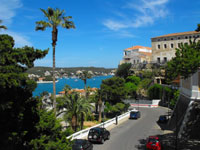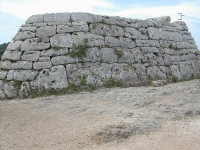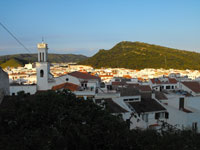Minorca Travel Guide
Despite its popularity as a beach holiday paradise, the Balearic Island of Minorca remains one of the loveliest, most unspoilt islands in the Mediterranean. The local population support the control of resort development, and the woodlands and fields of its hilly rural interior remain largely untouched by the tourism trade.
This is the result of a thriving local industry that's less dependent on tourism for its survival than many of the other islands are. So, Minorca is a great option for travellers who want a more authentic Spanish beach resort holiday. Minorca is only nine miles (15km) wide and about 32 miles (52km) long, and boasts stretches of varied beaches, from silver-sanded, gently curving bays to rugged, rocky inlets.
Aside from beaches and resorts, the island also has plenty of interest for history buffs and culture connoisseurs, as there are several attractions to visit, including a world famous pipe organ and several mysterious, prehistoric archaeological sites related to the second millennium BC Talayot culture. The more recent history of the island is a saga of British, French and Spanish attempts at control and colonisation, each of which have left their influence on the local culture and architecture.
Small as it may be, Minorca has a reliable and safe public transport system. Buses run from the Placa de s'Esplanada in Mahon regularly throughout the town and between other towns such as Fornells, Es Mercadal, Alaior, Ferreries, Ciutadella and Cala en Porter. Taxis can also be hailed from the Placa de s'Esplanada in Mahon. Rental car agencies can be found throughout the towns and at the airport.
Things to do in Minorca
Minorca offers a few historic sightseeing opportunities, but the most noteworthy places worth visiting are the exquisite, unspoilt beaches with their soft, white sand and crystalline waters, and the fantastic old seaside villages that are an attraction in themselves. In Mahon, travellers can explore the waterfront, take a tour of the 3.5 mile-long (5.6km) natural harbour on a glass-bottom boat, visit the Xoriguer Gin Distillery and admire the beautiful architecture. They can also take a day trip to the sleepy fishing village of Fornells in the north, where they can enjoy a lazy lunch and spot of shopping, and perhaps arrange a scuba dive in the marine reserve.
Other places of interest include Arenal D'en Castell, a peaceful, pretty beach resort on the north coast, with a lovely beach in a protected bay; Calan Porter (also called Cala'n Porter), which is a popular and picturesque town set in a rugged cove; the 13th-century town of Ferreries, which is set in lush hills and is close to some historical remains, including a ruined Moorish castle; and Ciutadella, a charming port city with a rich history. The Naveta des Tudons, found on Minorca, are remarkable, prehistoric archaeological sites that are thought to be ancient burial sites and are definitely worth seeing.

Mahon
Most visitors head straight for the string of restaurants and cafes lining the harbour of Mahon, Minorca's capital town. The town itself is sedate and conservative, featuring classic Georgian townhouses (bearing testimony to the British occupation of bygone days) and tall apartment blocks. Mahon does have some worthwhile attractions for those interested in making more of their holiday than dashing off to the beach. The mansion house of Golden Farm overlooks the harbour, and was once occupied by Admiral Lord Nelson. Also on the sightseeing list is the Xoriguer Gin Distillery, where famed Minorcan gin is produced in an age-old process. The celebrated organ (with more than 3,000 pipes) in the church of Esglesia de Santa Maria la Major is also a draw for some visitors.

Naveta des Tudons
Regarded as the cathedral of prehistoric monuments, the Naveta des Tudons is the best-known archaeological site on Minorca. One of numerous navetas on the island, it's situated just outside Ciutadella on the road from Mahon and stands two stories high. The structure is shaped like the upturned bow of a ship.
It's accepted that navetas were funereal structures, but they remain surrounded by mystery and legends. The Naveta des Tudons is Minorca's most remarkable megalithic chamber tomb as it's the largest and best preserved. The structure was used as a collective ossuary between 1200 and 750 BC, and held the remains of more than 100 skeletons. The interior is not accessible to the public but it's still well worth visiting the site.

Ferreries
Surrounded by rolling green hills, the 13th-century town of Ferreries lies nestled in the centre of Minorca next to the island's second highest mountain. Travellers are attracted to the area by the Castell de Santa Agueda, which is the ruin of a Moorish castle built atop an ancient Roman stronghold. It exists as the last site of resistance for Arab inhabitants when the island was conquered by King Alfonso III of Aragon. The ruined fortress is accessed via an ancient Roman road and there's a chapel dedicated to Saint Agatha next to the castle. Ferreries itself is a sleepy little place, with a character typical of the island. It's a great place to buy local produce as the region is particularly celebrated for its cheeses.
Shopping
Most of the towns, and particularly the resorts, in Minorca are full of the usual gift shops selling tourist tat, but exciting shopping opportunities abound in Mahon. Visitors should head towards the centre of town where the cobblestoned streets are lined with boutiques, clothing shops, jewellers, ice-cream parlours and shoe stores.
The popular tourist areas are also loaded with shops. Mahon has a wonderful market every Sunday where anything from clothing to fresh food and produce can be bought, and there's good shopping to be had in Ciutadella and Mao. Ses Voltes street is the place to head in Ciutadella; the area around Carrer Ses Moreres in Mao is a good bet for designer gear. Both towns have artisan markets, which are open on Friday evenings in Mao, and on Friday, Saturday and Sunday evenings in Ciutadella.
Great souvenirs to bring home from Minorca include traditional leather sandals called Albarques leather goods, jewellery and the Minorcan gin, Xoriguer. Most shops open between 9am and 9pm, but close between 2pm and 5pm for siesta. Tourist shops are sometimes open during siesta hours.
Nightlife
Unlike its Balearic neighbor, Ibiza, which offers wild parties where party people can dance the night away, Minorca's nightlife is laid-back and centred round hotels, quiet bars, restaurants and the occasional nightclub. In the capital, Mahon, there are a few live music bars, pubs and tavernas that are perfect for soaking up the views and atmosphere while sipping on a cocktail, but even these are easy-going.
Resort towns, such as Cala En Porter, offer visitors themed bars, but most of them close before midnight. Minorca is ideal for holidaymakers who want to combine a beach holiday with excursions to picturesque historic towns and outings into the charming rural interior, and is unlikely to impress young party animals. The island is well-equipped with venues for the enjoyment of cocktails, local live music and some dancing, but it's not considered a great nightlife destination.
Minorca Climate and Weather
Minorca enjoys a Mediterranean climate, with mild winters and hot, dry summers. Experiencing about 315 days of sunshine a year, the destination has a gorgeous climate for holidaymakers. July and August are by far the hottest months with temperatures reaching over 86°F (30°C). Winter, between December and February, is mild and often sunny.
The wettest months are October, November, and December. The north wind known as the tramontana blows regularly in Minorca, bringing with it changeable weather. The island's climate can be rather unpredictable but the summer season, between June and September is consistently dry and hot.
The peak summer months, between June and August, are the most popular time to visit Minorca, but many argue that the best time to visit the island is spring, in April and May, when the wild flowers and blossoms ensure the landscapes are at their best and the weather is pleasantly warm. It's also less crowded and the prices tend to be lower (except over Easter). Many restaurants and some hotels close over the winter months when the island empties out.
Spain travel info
Electricity
The electrical current is 230 volts, 50Hz. European-style two-pin plugs are standard.
Language
Spanish is the official language, but English is widely understood in areas frequented by tourists. Catalan, Galician and Basque are spoken in the relevant areas.
Money
Spain's official currency is the euro (EUR), which is divided into 100 cents. Money can be exchanged at bureaux de change and major hotels, but banks give the best rates. All major credit cards are widely accepted at most hotels, restaurants, and shops. ATMs are widespread and are generally the cheapest and most convenient method of obtaining money.
Tipping
Hotel and restaurant bills usually include service charges, but additional tips are welcomed for services rendered. In established restaurants, tips of about 10 percent are expected. Drivers of metered taxis expect small tips and it's customary to tip about 5 to 10 percent for most services, including guides.
Health
There are no health risks associated with travel to Spain, and no vaccination certificates are required for entry. Medical facilities are good but comprehensive travel insurance is always advised. Spain has a reciprocal health agreement with most EU countries that provides emergency health care for EU travellers on the same terms as Spanish nationals. After Brexit, the Global Health Insurance Card (GHIC) replaced the European Health Insurance Card (EHIC) for UK citizens. The GHIC allows UK citizens access to state healthcare during visits to the EU. The GHIC is not valid in Norway, Iceland, Liechtenstein or Switzerland, nor is it an alternative to travel insurance. EU travellers should take a European Health Insurance Card (EHIC). Travellers should take any medication they require along with them, in its original packaging and accompanied by a signed and dated letter from a doctor detailing what it is and why it is needed.
Safety
Most visits to Spain are trouble-free except for occasional street crime. Petty crime, such as pickpocketing and purse snatching, is most common in larger cities, particularly during holidays, festivals and weekends, and especially on public transport and in tourist areas. Thieves may work alone or in groups; visitors should be wary of strangers who offer or ask for help of any kind, or inform them of a stain on their clothes, as these are often ways of providing a distraction for accomplices. There are also scams involving letters for outstanding traffic fines or Spanish lottery winnings. Travellers can avoid incidents if they exercise all the normal precautions.
Local customs
Smoking in public places is banned and stiff fines will be imposed for smoking in areas such as enclosed public spaces, areas where food is prepared and sold, public transport, non-smoking areas of bars and restaurants, and any places that cater for children. Drinking alcohol in the streets of Madrid and the streets of the Canary and Balearic Islands is illegal.
Doing business
The business culture in Spain is slowly shifting but, for now, it's entrenched in tradition and it can take some time for foreigners to gain a foothold in the Spanish working world. It's important never to undermine authority as hierarchy is central to Spain's business world. Managers tend to make decisions without considering input from their colleagues.
A strong emphasis is placed on social status, character attributes, and personal pride. Success is often hinged upon being well-dressed, honourable, and dignified, while also exhibiting great social skills. Business meetings are generally conducted face-to-face and can go on for long periods, as Spaniards prefer long deliberations in order to avoid uncertainty in corporate dealings. Business meetings in Spain tend to tread a fine line between personal and formal.
Conducting business in Spain can entail navigation through a lot of red tape and bureaucracy. Spanish is the language of business, but some of the larger multinationals conduct meetings in both English and Spanish. Business hours are often quite varied, but generally open by 9am and close in the mid-evening with a two-hour lunch break during the early afternoon.
Business attire is quite conservative with men wearing dark or linen suits, shirts and silk ties. Women should wear modest dresses or tailored suits. Brand names or labels attract affirmation from colleagues and associates.
After the conclusion of successful negotiations, gifts are appropriate. Gifts should be of high quality and, when receiving a gift, it should be opened in front of the giver. Business cards are important and should be bilingual. Meetings are best scheduled for mid-morning, and establishing a formal yet personable environment is important before beginning. Meetings often occur over lunches and dinners.
Duty free
Travellers from EU countries are allowed the following items duty free: 800 cigarettes or 400 cigarillos or 200 cigars or 1kg tobacco; 110 litres beer; 90 litres wine; and 10 litres spirit. Travellers from non-EU countries may have 200 cigarettes or 100 cigarillos or 50 cigars or 250g tobacco; 1 litre spirits, 4 litres wine, and 16 litres beer.
Communications
The international access code for Spain is +34. WiFi is widely available; travellers can purchase local SIM cards for unlocked phones or use eSIMs if their cellular providers support it on their networks.
Passport & Visa
The borderless region known as the Schengen area includes the following countries: Austria, Belgium, Czech Republic, Denmark, Estonia, Finland, France, Germany, Greece, Hungary, Iceland, Italy, Latvia, Lithuania, Luxembourg, Malta, The Netherlands, Norway, Poland, Portugal, Slovakia, Slovenia, Spain, and Sweden. All these countries issue a standard Schengen visa that has a multiple entry option, allowing the holder to travel freely within the borders of all. Non-EU nationals must hold a return or onward ticket, all necessary documents for onward travel and sufficient funds. It is highly recommended that passports have at least six months' validity remaining after the intended date of departure from Spain. Immigration officials often apply different rules to those stated by travel agents and official sources.
Entry requirements
United States citizens require a passport valid for three months beyond the period of intended stay. No visa is required for stays of up to 90 days within a 180 day period.
British citizens require a passport valid for three months beyond the period of intended stay. No visa is required for stays of up to 90 days within a 180 day period.
Canadian citizens require a passport valid for at least three months beyond period of intended stay. No visa is required for stays of up to 90 days within a 180 day period.
Australian citizens require a passport valid for at least three months beyond period of intended stay. No visa is required for stays of up to 90 days within a 180 day period.
South African citizens require a passport valid for at least three months beyond period of intended stay. A visa is required.
Irish nationals require a valid passport, but a visa is not necessary.
New Zealand citizens require a passport valid for at least three months beyond period of intended stay. No visa is required for stays of up to 90 days within a 180 day period.
Useful contacts
Spanish Tourist Office, Madrid: www.spain.info.
112 (General).


